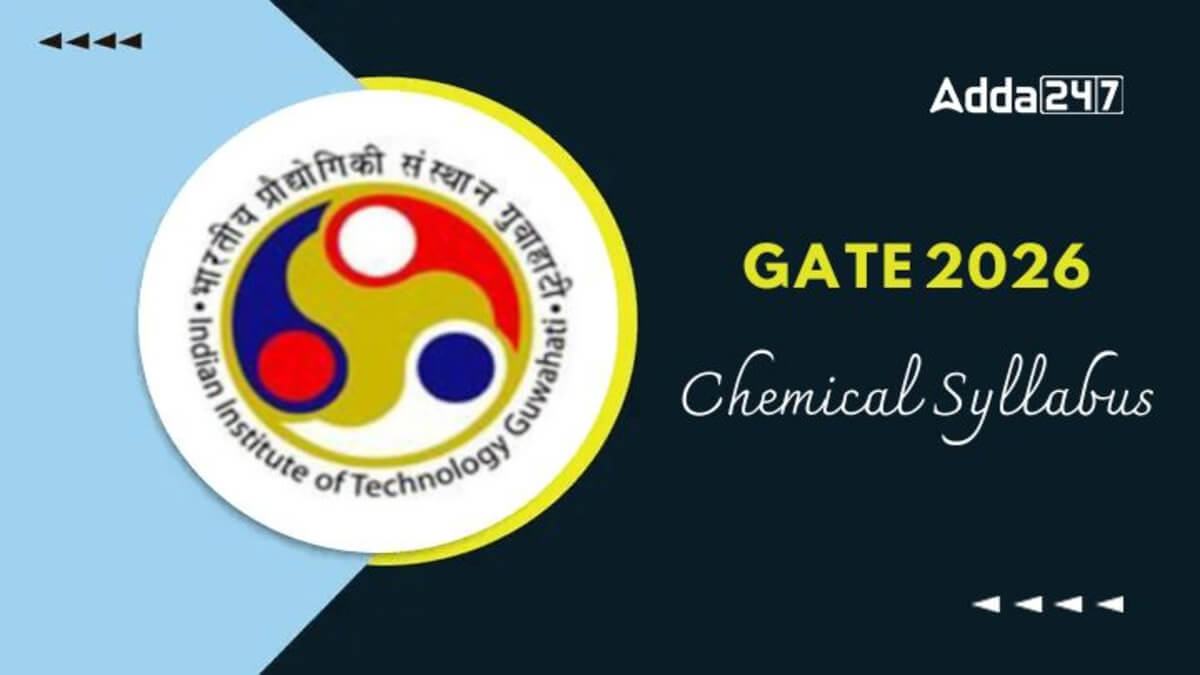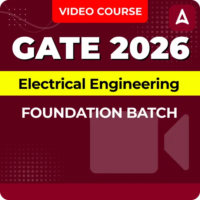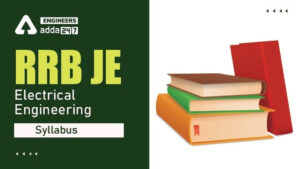Table of Contents
The Indian Institute of Technology (IIT) Guwahati has released the GATE Chemical Engineering Syllabus 2026 on its official website at www.iitg.ac.in. IIT Guwahati will conduct the GATE 2026 exam in February 2026 for students who want to get admission into master’s programs and get good engineering jobs in various Public Sector Undertakings. This page provides the complete GATE Chemical Engineering Syllabus 2026 to help students prepare better and score higher in the exam. This article explains the detailed syllabus for Chemical Engineering to support aspirants in their exam preparation.
GATE Chemical Engineering Syllabus 2026
If you are preparing for GATE 2026 in Chemical Engineering, it is very important to have a clear understanding of the GATE Chemical Engineering 2026. Knowing the syllabus is the first and most important step toward your exam preparation. This article will help you get complete details about the syllabus so that you can plan your studies in the right direction. To score well in the GATE 2026 exam, you must carefully study and cover every part of the Chemical Engineering syllabus.
GATE CH Syllabus 2026-Overview
The aspirants from the Chemical Engineering discipline going to appear in the GATE 2026 Exam must refer to the section below to get a detailed overview of the GATE Chemical Engineering syllabus 2026.
| GATE Chemical Engineering Syllabus 2026 | |
| GATE Full Form | Graduate Aptitude Test for Engineering (GATE) |
| GATE 2026 Conducting Authority | IIT Guwahati |
| GATE 2026 Number of Papers | 30 |
| GATE 2026 Mode of Exam | Computer-Based Test (CBT) |
| GATE 2026 Chemical Exam | 07 February, 08 February, 14 February, 15 February 2026 |
| Number of Questions Asked | 65 |
| GATE 2026 Marks Distribution | 15 Marks (General Aptitude) + 85 Marks (Subject Questions)= 100 Marks (Total) |
| GATE Exam Language | English |
| GATE 2026 Marking Scheme | One Mark and Two Marks |
| Negative Marking | Yes |
| GATE Official Website | @gate.iisc.ac.in |
GATE Chemical Engineering Exam Pattern 2026
The GATE 2026 Chemical Engineering Paper will ask questions to check your Application, Analysis, Comprehension, Recall, and Synthesis abilities. The GATE 2026 Question Paper will comprise the questions in either MCQ, MSQ & NAT (Numerical Answer Type).
The candidates must check the GATE 2026 Exam Pattern for Chemical Engineering through the table given below to get a clear idea about the GATE 2026 Paper Scheme for the Chemical Engineering branch.
| GATE Chemical Exam Pattern 2026 | |
| GATE Exam 2024 Mode | Computer-Based Test (Online) |
| Exam Duration | 3 Hours |
| No. of Subjects | 30 Subjects |
| Total Marks | 100 Marks |
| Number of Questions | 10 (GA) + 55 (subject) = 65 Questions |
| Type of Questions | Multiple Choice Questions (MCQs), Multiple Select Questions (MSQs), and Numerical Answer Type Questions (NATs) |
GATE Chemical Syllabus In Detail
The topic-wise, detailed GATE Chemical Engineering Syllabus is given here to help students aiming to crack it with a good score. You must go through the GATE 2026 Chemical Engineering Syllabus prescribed below:
Section 1- Engineering Mathematics
Linear Algebra
- Matrix algebra
- systems of linear equations
- eigenvalues and eigenvectors
Calculus
- Functions of a single variable
- limit
- continuity and differentiability
- mean value theorems
- indeterminate forms
- evaluation of definite and improper integrals
- double and triple integrals
- partial derivatives
- total derivative
- Taylor series (in one and two variables)
- maxima and minima
- Fourier series
- gradient
- divergence and curl
- vector identities
- directional derivatives
- line, surface, and
- volume integrals
- Applications of Gauss
- Stokes’s and Green’s theorems
Differential Equations
- First-order equations (linear and nonlinear)
- higher-order linear differential equations with constant coefficients
- Euler-Cauchy equation
- initial and boundary value problems
- Laplace transforms
- solutions of heat, wave, and Laplace’s equations
Complex Variables
- Analytic functions
- Cauchy-Riemann equations
- Cauchy’s integral theorem and
- integral formula
- Taylor and Laurent series
Probability and Statistics
- Definitions of probability
- sampling theorems
- conditional probability
- mean, median, mode, and standard deviation
- random variables
- binomial
- Poisson and normal distributions
Numerical Methods
- Numerical solutions of linear and non-linear algebraic equations
- integration by trapezoidal and Simpson’s rules
- single and multi-step methods for differential equations
Section 2- Process Calculations and Thermodynamics
Steady and unsteady state mass and energy balances include multiphase, multicomponent, reacting, and non-reacting systems. Use of tie components; recycle, bypass, and purge calculations; Gibbs’ phase rule and degree of freedom analysis; First and Second laws of thermodynamics. Applications of the first law to closed and open systems. Second Law and Entropy. Thermodynamic properties of pure substances: Equation of State and residual properties, properties of mixtures: partial molar properties, fugacity, excess properties, and activity coefficients; phase equilibria: predicting VLE of systems; chemical reaction equilibrium
Section 3- Fluid Mechanics and Mechanical Operations
Fluid statics, surface tension, Newtonian and non-Newtonian fluids, transport properties, shell-balances including differential form of Bernoulli equation and energy balance, equation of continuity, equation of motion, equation of mechanical energy, Macroscopic friction factors, dimensional analysis and similitude, flow through pipeline systems, velocity profiles, flow meters, pumps and compressors, elementary boundary layer theory, flow past immersed bodies including packed and fluidized beds, Turbulent flow: fluctuating velocity, universal velocity profile and pressure drop. Particle size and shape, particle size distribution, size reduction and classification of solid particles; free and hindered settling; centrifuge and cyclones; thickening and classification, filtration, agitation and mixing; conveying of solids.
Section 4- Heat Transfer
Equation of energy, steady and unsteady heat conduction, convection and radiation, thermal boundary layer and heat transfer coefficients, boiling, condensation and evaporation; types of heat exchangers and evaporators and their process calculations; design of double pipe, shell and tube heat exchangers, and single and multiple effect evaporators.
Section 5- Mass Transfer
Fick’s laws, molecular diffusion in fluids, mass transfer coefficients, film, penetration, and surface renewal theories; momentum, heat, and mass transfer analogies; stage-wise and continuous contacting and stage efficiencies; HTU & NTU concepts; design and operation of equipment for distillation, absorption, leaching,liquid-liquid extraction, drying, humidification, dehumidification, and adsorption, membrane separations (micro-filtration, ultra-filtration, nano-filtration and reverse osmosis).
Section 6- Chemical Reaction Engineering
Theories of reaction rates; kinetics of homogeneous reactions, interpretation of kinetic data, single and multiple reactions in ideal reactors, kinetics of enzyme reactions (Michaelis-Menten and Monod models), non-ideal reactors; residence time distribution, single parameter model; non-isothermal reactors; kinetics of heterogeneous catalytic reactions; diffusion effects in catalysis; rate and performance equations for catalyst deactivation.
Section 7- Instrumentation and Process Control
Measurement of process variables; sensors and transducers; P&ID equipment symbols; process modeling and linearization, transfer functions and dynamic responses of various systems, systems with the inverse response, process reaction curve, controller modes (P, PI, and PID); control valves; transducer dynamics; analysis of closed-loop systems including stability, frequency response, controller tuning, cascade, and feed-forward control.
Section 8- Plant Design and Economics
Principles of process economics and cost estimation, including depreciation and total annualized cost, cost indices, rate of return, payback period, discounted cash flow, optimization in process design, and sizing of chemical engineering equipment such as heat exchangers and multistage contactors.
Section 9- Chemical Technology
Inorganic chemical industries (sulfuric acid, phosphoric acid, chlor-alkali industry), fertilizers (Ammonia, Urea, SSP and TSP); natural products industries (Pulp and Paper, Sugar, Oil, and Fats); petroleum refining and petrochemicals; polymerization industries (polyethylene, polypropylene, PVC and polyester synthetic fibers).
GATE Chemical Engineering Syllabus PDF
The candidates can download the GATE Chemical Engineering Syllabus PDF through the direct link given below. The candidates must refer to the syllabus to enhance their preparation for the GATE 2026 Test. A proper understanding of the Chemical Syllabus 2026 will help the candidates to get good marks and success, as they can plan and strategize beforehand as per the GATE Chemical Engineering Syllabus 2026.
GATE Chemical Engineering Syllabus 2026- Click Here




 RRB JE Mechanical Syllabus 2026, Check D...
RRB JE Mechanical Syllabus 2026, Check D...
 RRB JE Electrical Syllabus 2026, Check E...
RRB JE Electrical Syllabus 2026, Check E...
 TNPSC CTS Syllabus 2026, Subject Wise Sy...
TNPSC CTS Syllabus 2026, Subject Wise Sy...





